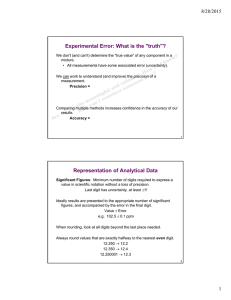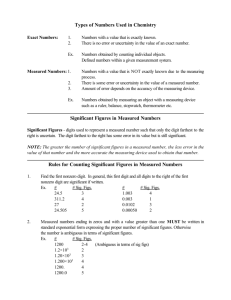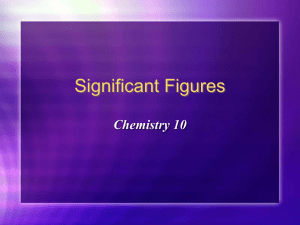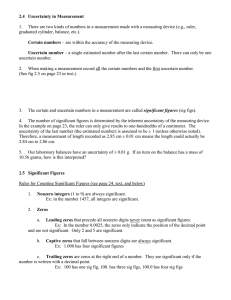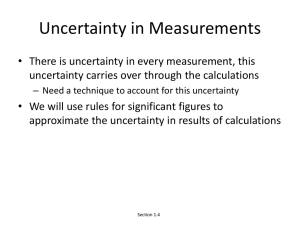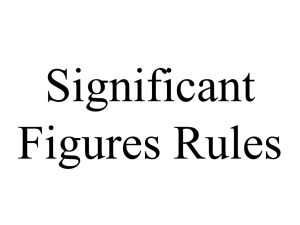Dealing with quantitative data and problem solving…life is a story problem!
advertisement
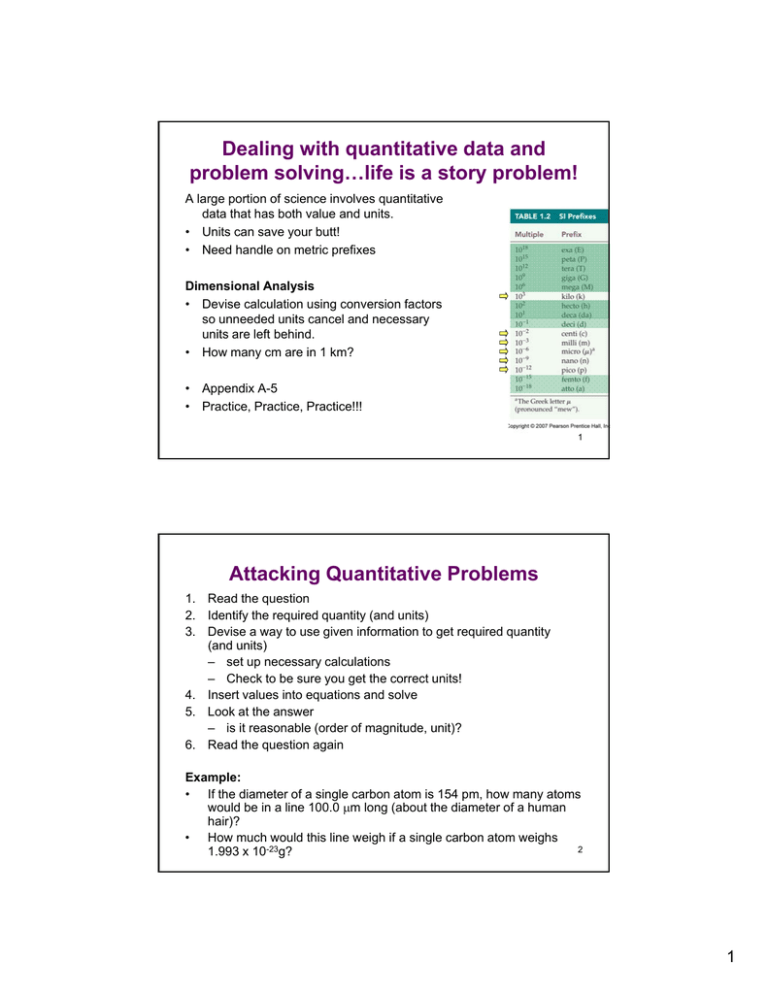
Dealing with quantitative data and problem solving…life is a story problem! A large portion of science involves quantitative data that has both value and units. • Units can save your butt! • Need handle on metric prefixes Dimensional Analysis • Devise calculation using conversion factors so unneeded units cancel and necessary units are left behind. • How many cm are in 1 km? • Appendix A-5 • Practice, Practice, Practice!!! 1 Attacking Quantitative Problems 1. Read the question 2. Identify the required quantity (and units) 3. Devise a way to use given information to get required quantity (and units) – set up necessary calculations – Check to be sure you get the correct units! 4. Insert values into equations and solve 5. Look at the answer – is it reasonable (order of magnitude, unit)? 6. Read the question again Example: • If the diameter of a single carbon atom is 154 pm, how many atoms would be in a line 100.0 m long (about the diameter of a human hair)? • How much would this line weigh if a single carbon atom weighs 2 1.993 x 10-23g? 1 What can a result tell us? What is the "truth"? • We don't (and can't) determine the "true value" of any component in a mixture. – All measurements t h have some associated i t d error ((uncertainty). t i t ) – Representation of results must illustrate this error; otherwise value is useless! • We can work to understand (and improve) the precision of a measurement. – Precision = • Comparing multiple methods increases confidence in the accuracy of our results. – Accuracy = 3 Representation of Quantitative Data Significant Figures: Number of digits necessary to present a result with the appropriate accuracy. – Last digit has uncertainty, at least 1! • Results are presented to the appropriate number of significant figures, and often accompanied by the error in the final digit. Value Error e.g. 102.5 0.1 ppm • When rounding, look at all digits beyond the last place needed. • Always round values that are exactly halfway to the nearest even digit. 12.250 12.2 12.350 12.4 12.250001 12.3 4 2 Guidelines for Sig. Figs. When looking at a number: 1. all nonzero digits are significant, 2 allll zeros th 2. thatt appear b between t nonzero di digits it off a number b are significant, 3. all zeros at the end of a number on the right hand side of the decimal point are significant, 4. all other zeros are not significant. Examples: How many significant figures in each value? 14600 0.0146 14060.0 10460 5 Sig. Figs. and Calculations In doing calculations, the number sig figs is limited by the least certain piece of data. – Addition/Subtraction – Multiplication/Division • Example: How many sig. figs. should be in the answers to the following: 126.23 + 0.0147 = 58.6 x 3.1 = • NOTE: Wait to truncate results until the end of the calculation! WHY??? • Indicate “extra” digits by subscripting: • Exact numbers don’t impact sig. figs. 6 3 Types of Error (Uncertainty) • Uncertainties fall into two main classes: – Systematic Error: – Random Error • Two general approaches to quantifying error: – Absolute Uncertainty – Relative Uncertainty, (% Relative Uncertainty) 7 Statistics and Quantitative Data • Statistics allow an estimation of uncertainty in our data. – AS LONG AS: • Two parameters define the distribution: : : • Statistical analyses relate experimental data to this “ideal” distribution. – BUT, there are some challenges! Fre equency of Observations • Foundation of statistics: Normal Distribution Observed Value 8 4 Statistics in Practice: Remember the key assumption! Describing the precision of our data. • Average, or Arithmetic Mean: – n is the number of samples x • xi i n Sample Standard Deviation: x i x 2 s i n 1 9 Describing the “uncertainty” in our data. How good is it? • When we determine an average (with some associated error), how sure are we that the "true value" is close to this a average? erage? – What factors influence this confidence? • The most common statistical tool for determining that the "true" value is close to our calculated mean is the confidence interval. – Th The confidence fid iinterval t l presents t a range about b t the th mean, within ithi which there is a fixed probability of finding the “true value”, m. x ts n 10 5 More on Confidence Limits • Values for t are tabulated based on several confidence levels and various numbers of degrees of freedom. Confidence Level (%) Degrees of Freedom 50 90 95 98 99 99.5 99.9 3 0.765 2.353 3.182 4.541 5.841 7.453 12.924 120 0.677 1.658 1.980 2.358 2.617 2.860 3.373 – NOTE: even though the number of measurements (n) is used in the CI calculation, t is determined based on the degrees of freedom (n-1). • Let’s look at some data: What is the average? What is the standard deviation (s)? What is the 95% confidence limit? 4.9761 4.9693 4.9713 4.8903 4.9631 4.9551 4.9586 5.0012 4.9781 4.9895 11 Error Propagation (aka propagation of uncertainty) How do errors in individual values affect an analysis? – Effects depend on how the data is used. – “Rules” “R l ” come ffrom calculus! l l ! Error Propagation in Addition and Subtraction: – Overall error is based on the absolute uncertainties of individual values. 2 2 e 4 e1 e 2 e 3 – Example: 2 12.4 0.2 5.7 0.1 + 1.43 0.04 19.53 ??? 12 6 More Error Propagation Error Propagation in Multiplication and Division – Concept is the same as addition and subtraction, except relative uncertainties are used 2 2 e e e e4 1 2 3 v4 v v 2 1 v3 %e 4 2 %e12 %e2 2 %e3 2 13 7
